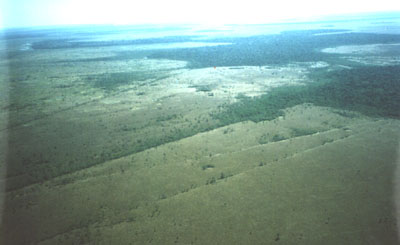
Posted on 05/30/2004 5:31:44 PM PDT by blam
Bird’s-Eye View of the Amazon Airborne Archaeologist Challenges the Myth of a Pristine Wilderness
by Ted Mann
In the office of a typical archaeologist, you would expect to find things like stone tools, pottery fragments, and maybe even a few Wooly Mammoth bones. But Clark Erickson is no typical archaeologist. Oversize rolls of aerial photographs are stacked into tubular pyramids on a desk and worktable in his University Museum office. They fill up file cabinets and populate a storage room. At last count, he had about 700 giant aerial and satellite images—almost all of them picturing some region of the Amazon.
He rolls out a 1958 U.S. Air Force photo of a Bolivian savannah. Even with the vast acreage blown up to movie-poster size, the details are as impenetrable as braille to the sighted. “See that,” he says, pointing to a line running across the landscape. “Anything that’s straight—it’s not natural.” With a finger, he traces a symmetrical block of toothpick shapes. “These are raised fields. See, you can pick out the linear patterns.” With Erickson’s narration, more and more geometric designs pop off the glossy print—settlement mounds, fish weirs, irrigation canals, roads. The photo begins to look like a prehistoric engineering blueprint. Unlike most archaeologists, Erickson doesn’t begin his research in excavated holes; he starts in the sky, reading the landscape for markers of vanished civilizations.
For the past decade, Erickson has used aerial images—borrowed from the military, scientists, and even oil companies—to guide his fieldwork. What he’s discovered about the prehistoric Amazon challenges many textbook teachings. Before Columbus, he argues, the area was heavily populated and agriculturally advanced. His work has led to a surprising supposition: Humans may have engineered nearly every aspect of the Amazon landscape.
As an undergraduate, Erickson wasted no time becoming an archaeologist. He was part of an excavation on the first day of freshman-year classes and then spent two summers at digs on Lake Titicaca in South America. The biggest discovery of his young career came at the end—in the rear-view mirror of a beat-up Volkswagen bus. The team was departing on a five-hour drive back to “civilization.” On an unpaved, uninhabited stretch of road, cresting over a ridge, Erickson stole one last glance at the diminishing lakebed. Through the cracked windows, he couldn’t believe what he saw: an unnatural crosshatch pattern. It covered several square miles, and it seemed to be human-made.
In this part of the Amazon, farming is difficult. The soil spends half the year scorched in desert heat and the other half inundated with rain. For this reason, say scholars, the region is incapable of sustaining large civilizations. Erickson believes the raised fields he glimpsed through the back window of his microbus were a solution hit upon by an ancient people. The system of mounds and canals provided irrigation in the dry season and drained the soil during floods. Ten years before, geographer William Denevan had written about the fields, but by the 1970s, when Erickson was there, no archaeologist had studied them. No one knew the age of the structures, who built them, or if they even worked.
By the time Erickson earned a Ph.D., he was itching to return. But as he hiked the dirt roads in search of the earthen structures he’d glimpsed before, the ancient fields seemed to have disappeared. From that point on, he says, “I vowed never to set foot on the landscape without having studied aerial photographs first.” Now he rents a $300-an- hour Cessna, and a team of three students helps him photograph the sites from every angle.
With aerial images, Erickson rediscovered the missing raised fields, and he immediately began analyzing them. Subsequent digs proved that the mounded fields date back to about 100 B.C. and may have been cultivated until A.D. 1100. The dimensions of the rectangular plots were astounding: Each row rose three feet high, measured up to 30 feet wide, and stretched 1,300 feet long. Between the rows were canals, also 30 feet wide and three feet deep.
As much as he learned about the fields, he kept coming back to one nagging question: Were they productive? To answer this, he tried a little “experimental archaeology”— recreating ancient tools and methods in order to better understand how the raised fields worked. With help from colleagues and local farmers, he built a field from scratch and worked it year-round. “We found that productivity was three to four times traditional practices like slash-and-burn,” he reports.
The more time Erickson spent in South America, the more he kept running into, and collaborating with, a group of sympathetic researchers, including Denevan and anthropologist William Balée. Together, the three men challenged conventional thinking about the Amazon. To begin with, they dismissed “the pristine myth” that the Americas before Columbus were an untouched Eden. Denevan countered that, in fact, much of the Amazon is anthropogenic—human made—and the sheer number of engineered earthworks and their size, he concluded, would have required a massive workforce.
Looking at an aerial photo of the Baures region of Bolivia, Erickson’s index finger dances between dark polka dots covering bare earth. These, he notes, are forest islands and mounds that can rise 60 feet above the savanna. Causeways radiate from them like spokes on a wheel. Erickson and Balée have shown that the mounds were once settlements, housing between 500 and 1,000 inhabitants. Beneath the canopies of the island forests, the two men discovered pottery, bones, and orchards of fruit trees. The dozens of raised causeways, however, still leave Erickson scratching his head. Most are straight as a ruler, stretching from mound to mound. “It looks like everyone in the society had their own road and used it once!”
For all the evidence that Erickson and his colleagues have offered, there is still resistance to the idea of a once populous Amazon. Old-school anthropol-ogists, like the Smithsonian’s Betty Meggers, hold that the region’s aluminum-rich soil couldn’t have supported the agricultural base a large civilization needs to thrive. Environmentalists push the “pristine myth” and, Erickson fears, often see his work as “some excuse that we’re giving developers to go and rape the Amazon.” Even natural scientists abhor the new anthropocentric view of the Amazon. “When I give talks at the Field Museum in Chicago, there is always a bunch of them literally yelling at me.” Meggers went so far as to claim, in the journal Latin American Antiquity, that “the myth of El Dorado is being revived by archaeologists.”
In an ironic twist, the lost gold of El Dorado may turn out to be that oft maligned soil. In the 1990s, geologists began examining Amazonian earth, and though much was inhospitable, large swaths turned out to be fertile. Called Amazonian Dark Earth, or terra preta by locals, this near-black soil has amazing properties. Dark Earth retains its nutrients during tropical rains, while other soil is leeched, and like potting soil, it is far more productive for growing crops. The trait that makes it so exceptional, and enigmatic, is its ability to regenerate. Locals quarry and farm the rich soil, and their supply always grows back. Dark Earth re-creates itself atop a base layer and grows—just like a living organism.
Scientists are still analyzing the biology, but Erickson believes the Amazon Indians enriched their earth with a microorganism, one that resisted depletion and helped fertilize. If better understood, this process of inoculating poor soil with a bacterial booster could aid parts of the undeveloped world starved for agriculture. Recently, geographers estimated that the creators of this ancient technology managed to terraform at least 10 percent of Amazonia—an area the size of France. Along with the raised fields, fish weirs, causeways, and other anthropogenic features, Dark Earth may in fact be one of countless footprints left by a lost civilization. Indeed, if Erickson is right, the Amazon could be humankind’s largest engineering relic.
Ted Mann, C’00, wrote for the winter issue.
For the last century and a half professional archaeologists have declared the mounds to be natural in origin, not manmade, because there are neither remains nor artifacts in the mounds (typical of Woodland Indians they know about).
The Jackson county culture is very similar to one of the earliest found on the Peruvian Pacific coast which also built mounds without artifacts or human remains in them. That culture also created an immense level plain in their settlement area.
Here an archaeologist has evidence of a third culture that built mounds (with some artifacts), as well as large level plains around them.
The mounds in Jackson County (mostly in and around Seymour, Indiana) were not "piled up" with thousands of baskets of dirt and sand. Rather, they look more like mounds "left behind" as the plain around them was flattened.
Just West of Seymour is a Council Circle used by American Indians. During the period of white expansion this circle served to provide the delineation of what's called the Ten O'Clock Line to the NW, and another survey line to the NE. These lines themselves parallel the Southernmost lines of a piece of astro-archaeology near Anderson, Indiana where paleo-Indians had constructed a series of mounds that mimic the Big Dipper constellation. Those mounds have no buried artifacts in them either, although there are other mounds in the area that do ~ those with astronimical significance are empty of identity!
We don't really know who built them.
I'd say this guy is on the right track once he starts identifying mounds and raised bed structures with astronomical significance.
At the same time "I" will be on an even bigger track having noted the similarities of two paleo-cultures 5,000+ miles apart!
HISTORIC NOTE: Freeman Field at Seymour was built right on this same level plain for use as a base for the Black Air Force of WWII.
bttt
Our technology progresses, while the societal conditions which make it possible, 'digress' (ungress? :^). At some point, the structure fails catastrophically, and weeds grow over the interstates.
We progress and antigress at the same time.
(I feel better...I suck at this posting stuff))
Words are fine, but if we don't get pictures in this Internet thing, we will file all this in the same drawer with Hoagland's Martian stuff.
1100 years ago category 5 hurricanes were much more frequent than today. I often wonder if they were a refuge from the flooding from these 'super hurricanes.'
15 feet is typical; there are some taller ones about 20 feet high.
Adena and Hopewell structures are far larger, made of earth, and ordinarily have human remains and artifacts buried in them.
These are the ones I was referring to.
BTW, do you know who were the Adena? Have you read the stories about giant skeletons (with double rows of teeth) that the early settlers claim to have found in the region?
Interesting, but I'd like to see some data that these conclusions are based upon.
Thanks for the link, I'd forgotten that one.

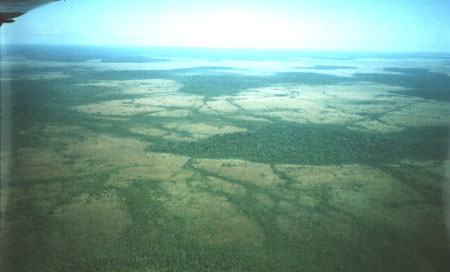
| Here is a collection of images relating to the recent article by Dr. Clark Erickson on fishweirs in the Bolivian Amazon. Click each thumbnail to view an larger version. All photos are available in high-resolution versions (approximately 1980 x1340 pixels). Email Clark Erickson at cerickso@sas.upenn.edu for details. Click here for a link to image captions All information contained on this site is EMBARGOED by the Journal Nature unil 2 p.m. EST November 8, 2000 |
|||
 |
 |
 |
 |
| 01 | 02 | 03 | 04 |
 |
 |
 |
 |
| 05 | 06 | 07 | 08 |
 |
 |
 |
 |
| 09 | 10 | 11 | 12 |
 |
 |
 |
 |
| 13 | 14 | 16 | 17 |
 |
 |
 |
 |
| 18 | 19 | 20 | 21 |
 |
 |
 |
 |
| 22 | 23 | 24 | 25 |
 |
 |
 |
 |
| b01 | b02 | b03 | b04 |
 |
 |
 |
 |
| b05 | b06 | b07 | b08 |
 |
 |
 |
 |
| b09 | b10 | b11 | b12 |
 |
 |
 |
|
| b13 | b14 | b15 | |
| Click here for a link to image captions |
|||
| Here is a collection of figures pertaining to the recent article by Dr. Clark Erickson on fishweirs in the Bolivian Amazon. Click each thumbnail to view an Adobe Acrobat pdf file All information contained on this site is EMBARGOED by the Journal Nature unil 2 p.m. EST November 8, 2000
All images, figures, and related information are the property of Clark Erickson. ©2000 Clark L. Erickson. |
|||
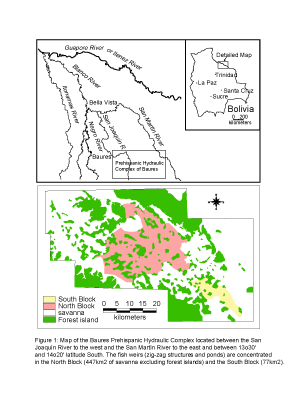 |
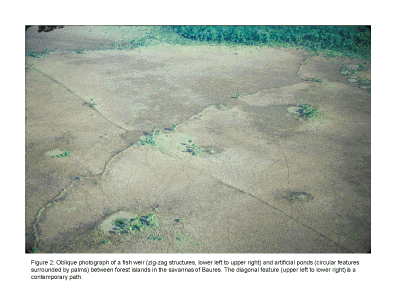 |
||
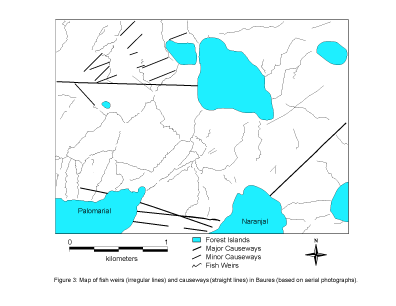 |
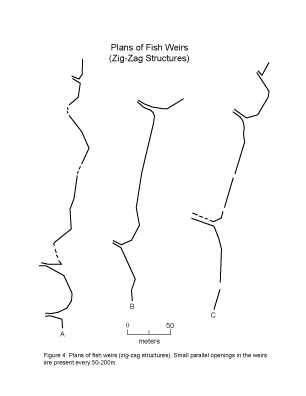 |
||
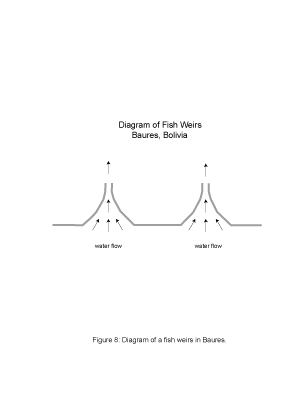 |
 |
||
 |
|||
very cool pictures. Thanks for the addition.
|
|
|
Prehispanic raised fields in the savannas of the Llanos de Moxos of Bolivia. The elevated planting platforms are 20 meters wide, 0.2-1 meter tall, and up to 600 meters long. |
Thank you for posting this very interesting article. b.
Hey RightWhale, we have (more than words) pictures.
Disclaimer: Opinions posted on Free Republic are those of the individual posters and do not necessarily represent the opinion of Free Republic or its management. All materials posted herein are protected by copyright law and the exemption for fair use of copyrighted works.